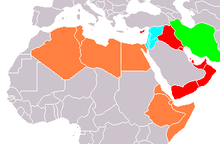Anglican Diocese of Egypt
| Diocese of Egypt with North Africa and the Horn of Africa ابروشية الكنيسة الأسقفية بمصر (in Arabic) | |
|---|---|
| Location | |
| Country | Egypt |
| Territory | North Africa and the Horn of Africa |
| Ecclesiastical province | Province of Jerusalem and the Middle East |
| Information | |
| Denomination | Anglican |
| Established | 1920[1] |
| Cathedral | All Saints' Cathedral, Zamalek, Cairo, Egypt |
| Current leadership | |
| Bishop | Mouneer Hanna Anis |
| Map | |
 Diocese of Egypt and North Africa Diocese of Jerusalem Diocese of Cyprus and the Gulf Diocese of Iran | |
| Website | |
| www.dioceseofegypt.org/english/ | |
The Anglican / Episcopal Diocese of Egypt with North Africa and the Horn of Africa is a diocese of the Episcopal Church in Jerusalem and the Middle East. It was originally part of the Diocese of Jerusalem, founded in 1841 by the Archbishop of Canterbury. The Diocese of Egypt was later given autonomy and its first bishop was Llwellyn Gwynne (1920-1946).[2]
Its jurisdiction extends over North Africa and the Horn of Africa, a vast region encompassing the following countries: Algeria, Tunisia,[3] Libya, Egypt, Ethiopia, Eritrea, Somalia and Djibouti. The diocese is part of the Province of Jerusalem and the Middle East, and is headed by the Bishop of Egypt. The current bishop is Mouneer Anis.[4]
Bishops
The following is a list of all Anglican Bishops in Egypt:[5]
Bishop in Egypt and the Sudan:
- Llewellyn Gwynne (1920–1946)
- Assistant bishop: Morris Gelsthorpe[6]
The Diocese of Sudan was separated from Egypt in 1945.[7]
Bishops in Egypt:
- Geoffrey Allen (1947–1952)
- Francis Johnston (1952–1958)
- diocese suspended[8]
- Kenneth Cragg (1969–1974)
- Ishaq Musaad (1974–1984)
- Ghais Abdel Malik (1985–2000)
Bishops in Egypt with North Africa and the Horn of Africa:
- Mouneer Anis (since 2000)
Churches
Egypt
In Egypt itself the Diocese of thirteen churches and three "congregations" which "meet from time to time."[9]
There are three churches in the Alexandria metropolitan area
- St. Mark's Pro-Cathedral
- Christ the King Church, Ras el Soda
- All Saints Church, Stanley Bay
A number of churches are in the Greater Cairo area.
- All Saints Cathedral, Zamalek
- Jesus Light of the World Church, Old Cairo
- Church for the Deaf, Old Cairo
- Church of the Good Shepherd, Heliopolis
- St. John the Baptist Church, Maadi
- Church of the Good Shepherd, Giza
Other churches are spread throughout the country.
- St. Mark's Church, Menouf
- St Paul's Church, Ezbit en Nakhl
- Church of our Saviour, Suez
- Church of the Epiphany, Port Said
And the three "congregations" are located in Sadat City, 6th of October City and Hurghada.
Episcopal Area of North Africa
There are currently three Churches in the Episcopal Area of North Africa. The current Area Bishop is Sammy Fawzy.[10]
Episcopal Area of the Horn of Africa
According to the Diocese of Egypt, the Horn of Africa Episcopal Area includes work in the following countries: Djibouti, Eritrea, Ethiopia and Somalia.[11]
There is presently only one church in the Episcopal Area of the Horn of Africa. The current Area (Assistant) Bishop is Grant LeMarquand.[12]
- St. Matthew's Anglican Church, Addis Ababa, Ethiopia
- There is also extensive mission activity in the Gambela Region.[13]
See also
References
- ↑ Crockford's Clerical Directory 1975-76 London: Oxford University Press, 1976 ISBN 0-19-200008-X
- ↑ Miller, Duane Alexander (August 2011). "Book Review: THE EPISCOPAL CHURCH AND THE MIDDLE EAST BY CHARLES THORLEY BRIDGEMAN (NEW YORK: MOREHOUSE-GORHAM, 1958)" (PDF). St Francis Magazine. 7 (3): 125–128. Retrieved 15 November 2012.
- ↑ Strengholt, Jos (June 2012). "ST GEORGE'S ANGLICAN CHURCH, TUNIS A BRIEF HISTORY" (PDF). St Francis Magazine. 8 (3): 306–317. Retrieved 15 November 2012.
- ↑ "The Province of Jerusalem and the Middle East". Official website of the Episcopal Anglican Diocese of Egypt. Archived from the original on 2011-02-01. Retrieved 2011-04-08.
- ↑ "Bishops of the Diocese of Egypt". Official website of the Episcopal Anglican Diocese of Egypt. Retrieved 2011-04-08.
- ↑
- ↑
- ↑ Church of England (1999). The Church of England Year Book. Volume 115. Church House Publishing. p. 294. ISBN 978-0-7151-8103-4.
- ↑ Churches of Egypt
- ↑ The Episcopal Area of North Africa Archived February 6, 2013, at the Wayback Machine.
- ↑ "Horn of Africa". Diocese of Egypt. Retrieved 17 August 2013.
- ↑ The Episcopal Area of the Horn of Africa Archived February 6, 2013, at the Wayback Machine.
- ↑ Gambella Region Archived May 14, 2013, at the Wayback Machine.